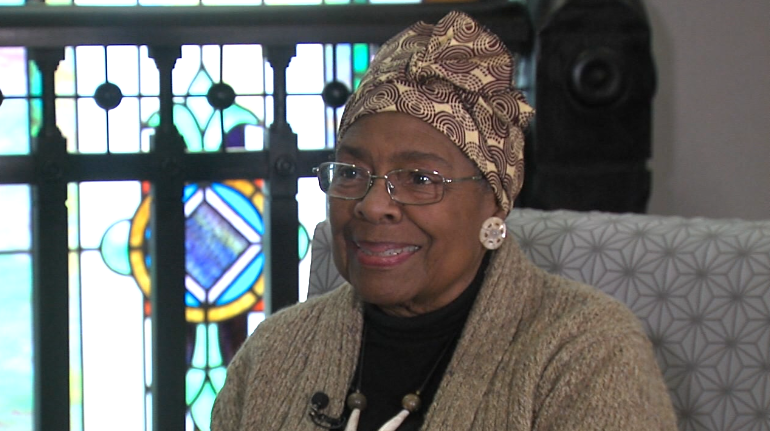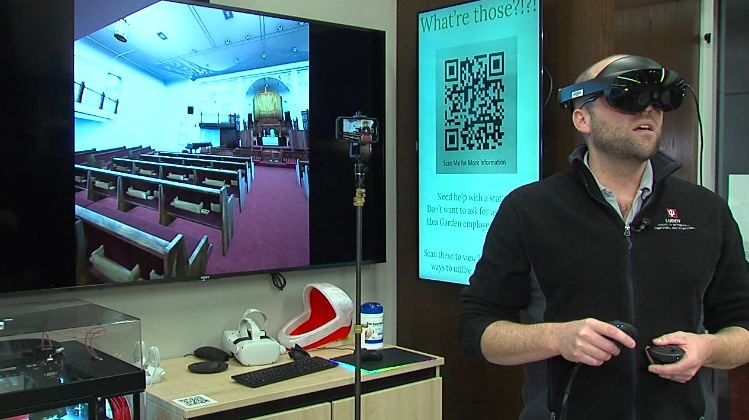INDIANAPOLIS — Today, it is a grand entry hall for a modern hotel on a short stretch of Vermont St., near the Canal Walk in downtown Indianapolis.
Its history as a house of worship, community center and cultural hub in Indianapolis' Black community spans nearly two centuries.
Olivia McGee Lockhart has been a member of the Bethel African Methodist Episcopal Church since she was a kindergartner.
She has learned and loves the history of the place and institution that has become so dear to her.

She recounts the first time she set foot in the place, when she was a 5-year-old girl.
"My grandmother grabbed my hand and said, 'Let's go!' And we continued to do that until her last day. So Bethel has been my life and place of worship all this time."
Miss Olivia, as some call her, has become an expert on Bethel AME and the people who made it so much more than a building.
She is our tour guide though history and around the old church building.

She believes the church's story is interweaved with the evolution of Indianapolis.
"Bethel Indianapolis grew with Indianapolis, the city," she says.
Bethel AME is the city's oldest African-American congregation, organized in 1836. Originally called "Indianapolis Station," its congregants met in the log cabin home of its founder, August Turner.
The church and its members were active in the anti-slavery movement and eventually moved to a small church building on Georgia Street, which served as a stop on the Underground Railroad — a network of routes, people and places aiding fugitive slaves on the journey from the South to freedom in Canada.

"For those who were fugitives, they found the Indianapolis Station and received help and assistance as best they could at the time," Miss Olivia says, "They didn't always stay too long. They had to keep moving."
Eventually, a fire, believed to have been set by anti-abolitionists, destroyed the Georgia St. location.
The church name had changed a couple of times. It had been known as Indianapolis Station and the Vermont Street Church. It's locations had changed too.
In 1867, Bethel AME Church hired an architect to build a brick structure, which would serve as the congregation's home until 2016.

The church not only served as a spiritual home base for its members, but also as a community center stepping up in times of crisis.
Miss Olivia recounts the church's role in the Great Flood of 1913, which devastated Indianapolis and its downtown area.
"Bethel served as a place, where those homes that had been destroyed, were able to come here to get food and clothing and probably just sleep here."
In the early 1900s, the Indianapolis chapter of the NAACP organized at Bethel, as did the Indiana State Federation of Colored Women's Clubs.
Some of Bethel's notable members over the years included Madam CJ Walker, the nation's first female African-American self-made millionaire — and Dr. Samuel Elbert, the first Black man to graduate from Medical College of Indianapolis.
By 2015, time has taken its toll on the building and the congregation tried to raise money for renovations and repairs, but ultimately decided it was time to move on. They vacated the Vermont St. location in 2016, since the cost of upkeep would be too much of a burden.
"I cried like a baby," Miss Olivia recalls, "We know the church is composed of people, but the place itself is so much a part of you, within you. You could close your eyes as a kid and walk through here."
That's exactly the experience faculty members at IUPUI aimed to recreate and offer, as preserving the history of the Bethel church building became a top priority.

Zebulun Wood is a lecturer at the Luddy School of Informatics, Computing, and Engineering at IUPUI and specializes in 3-D animation.
In 2017, Wood led a project with his students called "Virtual Bethel" to create a virtual reality rendition of the historic Bethel AME Church.
"Historical preservation was something I was curious about," Wood says, "[Virtual reality] needs the same skill sets as video games and we started asking ourselves how can we create this historical importance of this space in a way anyone can try it out."

It feels like you're standing in the sanctuary.
The interactive virtual reality experience allows users to walk through and look around the church as it was.
It also engages users to read about the church's history, pastors and notable members.
The preservation efforts did not stop with "Virtual Bethel."

Professor Andrea Copeland is the Chair of the Department of Library and Information Science at the Luddy School at IUPUI.
She wrote grants to fund preservation projects and worked with Olivia McGee Lockhart, who was the steward of the church's archive, to collect and catalog artifacts and share those with local historic institutions, like the Indiana State Museum and the Indianapolis Central Library, to name a few.
"This was a rich treasure for the city and for the people of the city because it told the story of contributions of African-Americans to the development of our city," Copeland says.
The church building on Vermont St. was added to the National Historic Registry in 1991.

Preserving the historic integrity and its story was key for the developers working since 2016 on the Hampton Inn Hotel project.
The ministers at Bethel AME Church worked with the developers during the planning and construction.
Hotel General Manger Ashley Ramirez says, "You're checking into history."
The pulpits are part of the reception desk. The original stain glass windows are a prominent feature in meeting rooms.The communion and balcony railings accent the corridors. And the chandeliers still hang from the ceiling.
The staff is versed on the history and ready to share with any guests or locals ready to walk in and learn a lesson.
"The honor," Ramirez says,"that you have when they walk through the door and they go, 'Is this a church?' And you go, 'Yeah, let me tell you a story.''

For Miss Olivia McGee Lockhart, this is part of the journey.
"We have shared our story," she says, "You can preserve your history, so easily. You just have to take time to do it."
The Bethel AME Church congregation has relocated to its new facility on Zionsville road on the northwest side of Indianapolis and continues the outreach and community connection mission it started in the 19th century.
You can learn more about the history and see artifacts at the Indiana State Museum, the Indianapolis Central Library, IUPUI, and the historic building at the Hampton Inn Hotel on Vermont St. in downtown Indianapolis.
It's all open to the public.














